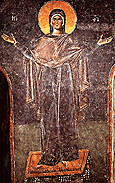| . |
||||||||
|
|
Painting: 1204-1261
It is probable that there was no single centre but that the new conditions allowed important artistic movements to develop in most of the regions of the old Empire. Thessalonike, a city with a great artistic tradition, was certainly a place of creation and dissemination of stylistic tendencies. The few samples of wall paintings in the
 the monumental-plastic tendency that we later find in the frescoes of the church of the Ascension in Mileseva, Serbia, founded by the Serb the monumental-plastic tendency that we later find in the frescoes of the church of the Ascension in Mileseva, Serbia, founded by the Serb
The monumental tendency, characterised by large figures with flowing drapery and expressive faces, is developed in the wall paintings of the church of the Holy Apostles in Pec, Serbia, which was founded by the archbishop Arsenios (1233-63). Arta, the capital city of the state of Epiros, must also have been an important artistic centre. The relatively recent discovery of wall paintings of
Together with the progressive plastic style may be observed a conservative return to the stylistic tendencies of Late Komnenian art. It is mainly encountered in provincial monuments in the Latin-occupied areas, although there are monuments funded by high-standing patrons, such as the double church of Sts. Nicholas and Panteleemon at Bojana in Bulgaria, founded by the sebastokrator Kalojan (1259), which follow the same trend.
|
||||||||||||||||||||||||||||||||||||||||